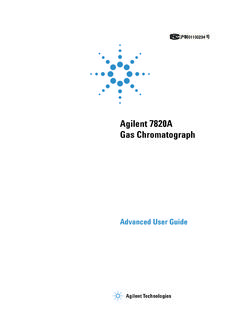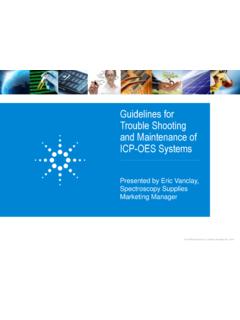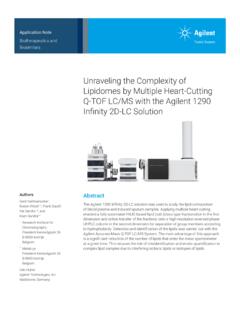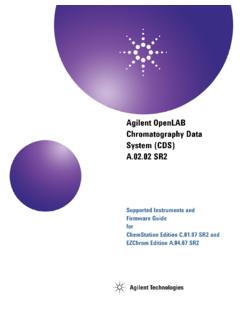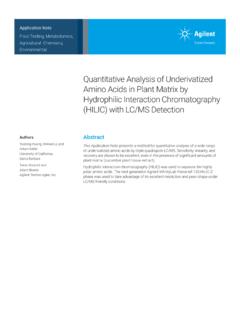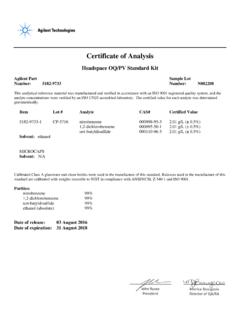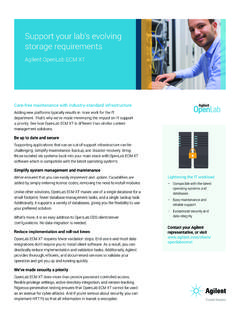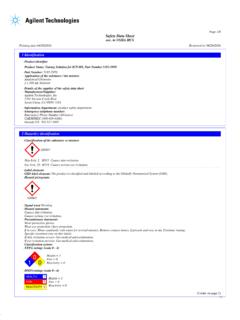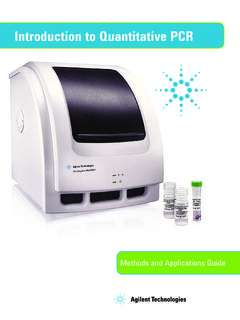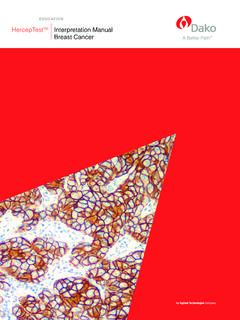Transcription of Seahorse XF Glycolysis Stress Test Kit User Guide
1 Agilent TechnologiesAgilent Seahorse XF Glycolysis Stress Test KitUser Guide Kit 103020-100 Notices Agilent Technologies, Inc. 2019No part of this manual may be reproduced in any form or by any means (including electronic storage and retrieval or transla-tion into a foreign language) without prior agreement and written consent from Agilent Technologies, Inc. as governed by United States and international copyright Part Number103020-400 Kit Part Number103020-100 EditionSecond edition, October 2019 Revision D0 Printed in USAA gilent Technologies, Inc. 2850 Centerville Road Wilmington, DE 19808-1610 USAW arrantyThe material contained in this docu-ment is provided as is, and is sub-ject to being changed, without notice, in future editions. Further, to the max-imum extent permitted by applicable law, Agilent disclaims all warranties, either express or implied, with regard to this manual and any information contained herein, including but not limited to the implied warranties of merchantability and fitness for a par-ticular purpose.
2 Agilent shall not be liable for errors or for incidental or consequential damages in connection with the furnishing, use, or perfor - mance of this document or of any information contained herein. Should Agilent and the user have a separate written agreement with warranty terms covering the material in this document that conflict with these terms, the warranty terms in the sep-arate agreement shall Licenses The hardware and/or software described in this document are furnished under a license and may be used or copied only in accordance with the terms of such Rights LegendIf software is for use in the performance of a Government prime contract or sub-contract, Software is delivered and licensed as Commercial computer soft-ware as defined in DFAR (June 1995), or as a commercial item as defined in FAR (a) or as Restricted computer software as defined in FAR (June 1987) or any equivalent agency regulation or contract clause. Use, duplication or disclosure of Software is subject to Agilent Technologies standard commercial license terms, and non-DOD Departments and Agencies of the Government will receive no greater than Restricted Rights as defined in FAR (c)(1-2) (June 1987).
3 Govern-ment users will receive no greater than Limited Rights as defined in FAR (June 1987) or DFAR (b)(2) (November 1995), as applicable in any technical NoticesCAUTIONA CAUTION notice denotes a hazard. It calls attention to an oper-ating procedure, practice, or the like that, if not correctly performed or adhered to, could result in damage to the product or loss of important data. Do not proceed beyond a CAUTION notice until the indicated conditions are fully understood and met. WARNINGA WARNING notice denotes a hazard. It calls attention to an operating procedure, practice, or the like that, if not correctly per-formed or adhered to, could result in personal injury or death. Do not proceed beyond a WARNING notice until the indicated condi-tions are fully understood and Seahorse XF Glycolysis Stress Test Kit User Guide3 ContentsIntroductionIntroduction 6 Glossary 8 Kit InformationKit Contents 10 Kit Shipping and Storage 10 Additional Required Items 11 AssayDay Prior to Assay 14 Day of Assay 15 Data Analysis 204 Agilent Seahorse XF Glycolysis Stress Test Kit User Guide5 Agilent Seahorse XF Glycolysis Stress Test KitUser GuideAgilent Technologies1 IntroductionIntroduction 6 Glossary 8 The Agilent Seahorse XF Glycolysis Stress Test is the standard assay for measuring glycolytic function in cells.
4 By directly measuring the extracellular acidification rate, (ECAR), see Figure 1 on page 7. The Seahorse XF Glycolysis Stress Test provides a standard and comprehensive method to assess the key parameters of glycolytic flux: Glycolysis , Glycolytic Capacity, Glycolytic Reserve, as well as nonglycolytic acidification. (Refer to the Glossary on page 8 for more details.)6 Agilent Seahorse XF Glycolysis Stress Test Kit User GuideIntroductionIntroductionGlycolysis and oxidative phosphorylation are the two major energy-producing pathways in the cell. Most cells possess the ability to switch between these two pathways, thereby adapting to changes in their environment. Glucose in the cell is converted to pyruvate (referred to as Glycolysis ), and then converted to lactate in the cytoplasm, or CO2 and water in the mitochondria. The conversion of glucose to pyruvate, and subsequently lactate, results in a net production and extrusion of protons into the extracellular medium (Figure 2 on page 7).
5 The extrusion of protons results in the acidification of the medium surrounding the XF instrument directly measures the acidification rate, and reports this as ECAR. The assay workflow is as follows. First, cells are incubated in the Glycolysis Stress test medium without glucose or pyruvate and the ECAR is measured. The first injection is a saturating concentration of glucose. The cells utilize the glucose injection and catabolize it through the glycolytic pathway to pyruvate, producing ATP, NADH, water, and extrusion of protons into the surrounding medium causes a rapid increase in ECAR. This glucose-induced response is reported as the rate of Glycolysis under basal conditions. The second injection is oligomycin, an ATP synthase inhibitor. Oligomycin inhibits mitochondrial ATP production, and shifts the energy production to Glycolysis , with the subsequent increase in ECAR revealing the cellular maximum glycolytic final injection is 2-deoxy-glucose (2-DG), a glucose analog, that inhibits Glycolysis through competitive binding to glucose hexokinase, the first enzyme in the glycolytic pathway.
6 The resulting decrease in ECAR confirms that the ECAR produced in the experiment is due to Glycolysis . The difference between glycolytic capacity and Glycolysis rate defines glycolytic reserve. ECAR, prior to glucose injection, is referred to as nonglycolytic acidification; caused by processes in the cell other than Seahorse XF Glycolysis Stress Test Kit User Guide7 Figure 1 Agilent Seahorse XF Glycolysis Stress Test profile of the key parameters of glycolytic function. Sequential compound injections measure Glycolysis , glycolytic capacity, and allow calculation of glycolytic reserve and nonglycolytic 2 Agilent Seahorse XF Glycolysis Stress Test Modulators of Glycolysis . This diagram illustrates a simplified version of Glycolysis and the sites of action of the kit components. Glucose fuels Glycolysis . Oligomycin inhibits ATP synthase in the mitochondria resulting in an increased dependence on Glycolysis . 2-DG is a competitive inhibitor of glucose, and functions to shut down Seahorse XF Glycolysis Stress Test Kit User GuideIntroductionGlossary Glycolysis : The process of converting glucose to pyruvate.
7 The XF Glycolysis Stress Test presents the measure of Glycolysis as the ECAR rate reached by a given cell after the addition of saturating amounts of glucose. Glycolytic capacity: This measurement is the maximum ECAR rate reached by a cell following the addition of oligomycin, effectively shutting down oxidative phosphorylation and driving the cell to use Glycolysis to its maximum capacity. Glycolytic reserve: This measure indicates the capability of a cell to respond to an energetic demand as well as how close the glycolytic function is to the cell s theoretical maximum. Nonglycolytic acidification: This measures other sources of extracellular acidification that are not attributed to 1 Agilent Seahorse XF Glycolysis Stress Test Reagents (in order of injection).Compound(s)TargetEffect on ECARG lucoseGlycolysisIncreaseOligomycin** Oligomycin is a mixture of Oligomycin A, B & C with Oligomycin A > 60%.ATP Synthase Complex V Increase2-DG 2-DG may appear clear, opaque (white), or as a mix of white solid and clear liquid.
8 Appearance does not affect Seahorse XF Glycolysis Stress Test KitUser GuideAgilent Technologies2 Kit InformationKit Contents 10 Kit Shipping and Storage 10 Additional Required Items 1110 Agilent Seahorse XF Glycolysis Stress Test Kit User GuideKit InformationKit ContentsThe Seahorse XF Glycolysis Stress Test Kit includes six foil pouches. Each pouch contains reagents sufficient for an assay in a full 96- or 24-well XF Cell Culture Microplate. Every pouch includes one tube of each of the following compounds: glucose, oligomycin, and 2-DG. See Table Shipping and StorageProduct ships at ambient temperature, and should be stored at room 2 Agilent Seahorse XF Glycolysis Stress Test Kit colorQuantity per tubeGlucoseBlue300 molOligomycinLight blue72 nmol2-DGGreen1,500 molKit InformationAgilent Seahorse XF Glycolysis Stress Test Kit User Guide11 Additional Required ItemsThe following items are also required for performing Seahorse XF Glycolysis Stress Tests.
9 They are not supplied with the kitsNarrow p1000 pipette tips are recommended for reconstituting compounds within the tubes provided (for example, Fisherbrand SureOne Micropoint Pipet Tips, catalog #: 02-707-402)Table 3 Additional required NumberAgilent Seahorse XFe/XF Analyzers Agilent TechnologiesFor XFe/XF96 Analyzers:XFe96 FluxPak mini orXFe96 FluxPak Agilent Technologies102601-100 or 102416-100 For XFe24 Analyzers:XFe24 FluxPak mini orXFe24 FluxPakAgilent Technologies102342-100or102340-100 XF base medium (500 mL or 2 L)** For a full list of all medium types and our recommendation for each assay kit, please refer to the Seahorse XF Media Selection Guide . Technologies103334-100 102353-100XF 200 mM Glutamine SolutionAgilent Technologies103579-10012 Agilent Seahorse XF Glycolysis Stress Test Kit User GuideKit Information13 Agilent Seahorse XF Glycolysis Stress Test KitUser GuideAgilent Technologies3 AssayDay Prior to Assay 14 Day of Assay 15 Data Analysis 20 Figure 3 Agilent Seahorse XF Glycolysis Stress Test Assay Seahorse XF Glycolysis Stress Test Kit User GuideAssayDay Prior to Assay1 Turn on the Seahorse XFe/XF Analyzer, and let it warm up to cells at a previously determined density in the Seahorse XF Microplate using the appropriate cell culture growth medium.
10 (For more information, refer to the Basic Procedure: Seeding Cells in Seahorse XF Culture Microplates available at a sensor cartridge in Seahorse XF Calibrant at 37 C in a non-CO2 incubator overnight. (Refer to Basic Procedure: Hydrating the Sensor Cartridge available at experiment in Wave. Visit Seahorse XF Glycolysis Stress Test Kit User Guide15 Day of AssayPrepare assay medium1 Prepare the assay medium by supplementing Seahorse XF Base Medium. Agilent Seahorse recommends 2 mM glutamine, as a starting point; however, desired medium composition can be varied depending on cell type or in vitro culture the assay medium to 37 the pH to with N NaOH (Note: Agilent Seahorse recommends sterile filtration following pH adjustment).4 Keep at 37 C until ready to stock compounds1 The Seahorse XF Glycolysis Stress Test Kit includes: Six foil pouches each containing oligomycin Six vials containing glucose Six vials containing 2-DGThe kit reagents are sufficient for six complete XF Glycolysis Stress Test assays in a 96 or 24-well Seahorse XF Cell Culture a foil pouch containing oligomycin (light blue cap) and remove one vial containing glucose (blue cap) and one vial containing 2-DG (green cap) from the kit a p1000 pipette, resuspend each component with prepared assay medium in volumes described in Table 4 on page 16.))
